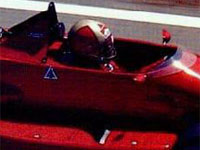The last non-F1 car to enter a Grand Prix
Author
- Mattijs Diepraam
Date
- 8W January 1999 issue
Related articles
- Gianni Morbidelli - The hard life of a promising Italian driving for a promising Italian team, by Mattijs Diepraam
Who?Alex Caffi What?BMS Scuderia Italia Dallara-Cosworth 3087 Where?Jacarepagua When?1988 Brazilian GP |
 |
Why?
The last time a car built to secondary-class regulations was entered in a World Championship Grand Prix was the 1988 Brazilian GP when BMS Scuderia Italia fielded an F3000 Dallara chassis for Alex Caffi. On only one other occasion an F3000 car was entered in a Grand Prix - exactly a year earlier, to be precise, when the rejuvenated March team entered an 87P for Ivan Capelli. On both occasions the team's F1 contender simply wasn't ready but both F3000 designs allowed for a 3.5-litre Cosworth to be stuck in the back.
Since Caffi's entry F1 and F3000 (formerly F2) have been totally separate entities. But it wasn't like that at all in the past. The histories of the pinnacle of motorsport and its secondary class are closely entwined, starting in 1952, when the governing body decided to ditch the existing F1 rule set in favour of F2 regulations. The next two seasons were run to these regulations, the move being aimed at stopping a much-feared Ferrari domination. This didn't quite help the opposition since Ferrari's F2 design, the 500, proved to be the class of the field all the same.
The trend towards nimble rear-engined cars was then followed through into the late fifties, years in which a mere engine change could make the difference between an F1 or F2 car - like with Ferrari's Dino, which had a 246 (F1) and 196 (F2) version.
The close relationship continued into the sixties after a bold move by the rule makers saw the F2 rules effectively becoming 1961's F1 regulations. The introduction of the 3-litre formula in 1966 saw a return of F2 cars on F1 grids, especially at the old 'Ring, the track hosting an F2 event within the F1 Grand Prix for three years running. In these days it was common practice for F1 stars to compete in F2 as well. Many of the great constructors, like Brabham, Lotus and Matra, produced both F1 and F2 chassis, with March coming into the picture in 1970. While in the seventies the champions started concentrating on F1 - a sign of growing professionalism in the sport, no doubt spurred on by the influx of sponsorship deals - young and upcoming F1 drivers such as Peterson and Jarier kept competing in F2 events, albeit ineligible for points. The rating system, dividing drivers into A and B categories, with only the B drivers competing for championship honours, lasted well into the seventies before the F2 championship grew into a category with a stature of its own.
The F2 championship blossomed in the late seventies and after a slow decline found a new lease of life with the inception of the 3,5-litre era in F1 and the sudden availability of the old Cosworth as the prime customer engine for a new category called F3000. Although having lacked visibility throughout its existence the category has been well entered over the years and has produced a respectable number of Grand Prix drivers, Coulthard, Alesi and Montoya the most successful.
Today, relations between the two series are getting closer again. The International F3000 series has been a "F1 Junior" championship since 2000, with every race on the '99 calendar already supporting Grands Prix. Also several F3000 outfits like West, Apomatox, RSM Marko and European are or have been actively supported and even governed by (former) F1 teams such as McLaren, Prost, Sauber and Minardi.
But the days it was common practice for F1 drivers to jump into an F2 car and compete in both series at the same time are definitely over. Imagine a F1 driver contacting the junior team for a bit of fun in the F3000 championship… It wouldn't be "professional" and regarded a distraction to the F1 team's multi-million dollar effort - apart from being looked upon as a degradation for the driver. When was the last time a washed-up F1 driver willingly stepped down to F3000 to further his career? The examples we remember, like Pierluigi Martini or Roberto Moreno, were more than a decade ago. Today, the common routes for seatless F1 has-beens are GTs or touring cars. Even the closest cooperation between the F1 and F3000 series won't change that.
